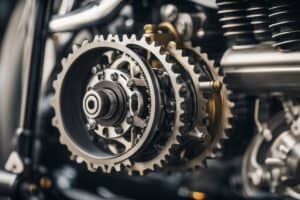If you’re a motorcycle owner, you may have encountered error codes while riding.
One of the most common error codes is P0106, which refers to a problem with the Manifold Absolute Pressure (MAP) or BARO Sensor.
This error code can be frustrating to deal with, but with some knowledge and troubleshooting, you can decipher the issue and get your motorcycle back on the road.
The MAP sensor is an important component of your motorcycle’s engine management system.
It measures the pressure inside the intake manifold and sends this information to the engine control module (ECM).
The ECM then uses this data to adjust the air/fuel mixture and ignition timing, ensuring optimal engine performance.
When the MAP sensor is not functioning properly, your motorcycle may experience issues such as poor acceleration, reduced power, or stalling.
The P0106 error code indicates that the ECM has detected a problem with the MAP sensor’s range or performance, which could be caused by a variety of factors.
Understanding Error Code P0106
If you are a motorcycle rider, then you know how important it is to keep your motorcycle in good working condition.
One of the ways to do this is by monitoring the error codes that your motorcycle’s computer generates.
One of the error codes that you may encounter is P0106.
P0106 is a code that indicates a problem with the Manifold Absolute Pressure (MAP) sensor or the Barometric Pressure (BARO) sensor.
These sensors are responsible for measuring the pressure in the intake manifold and the atmosphere, respectively.
When the MAP or BARO sensor detects an issue, it sends a signal to the motorcycle’s computer, which then generates the P0106 error code.
This code indicates that the sensor is detecting a range or performance issue.
There are several reasons why the MAP or BARO sensor may be malfunctioning.
Some of the common causes include a faulty sensor, a clogged air filter, a vacuum leak, or a problem with the wiring or connectors.
If you encounter the P0106 error code, it is important to address it as soon as possible.
Ignoring the code can lead to poor performance, decreased fuel efficiency, and even damage to your motorcycle’s engine.
To fix the issue, you may need to replace the faulty sensor, clean the air filter, repair any vacuum leaks, or fix any wiring or connector issues.
It is recommended to consult with a professional mechanic or refer to your motorcycle’s user manual for specific instructions on how to address the P0106 error code.
Symptoms of a Faulty MAP Sensor
When the Manifold Absolute Pressure (MAP) sensor in your motorcycle fails, it can lead to a variety of problems.
Here are some common symptoms of a faulty MAP sensor:
1. Engine Misfires
If your motorcycle’s engine is misfiring, it could be due to a faulty MAP sensor.
The sensor helps the engine control unit (ECU) determine the correct amount of fuel to inject into the engine.
If the sensor is not working properly, the engine may receive too much or too little fuel, causing it to misfire.
2. Poor Fuel Economy
A faulty MAP sensor can also lead to poor fuel economy.
If the sensor is not providing accurate readings to the ECU, the engine may receive too much fuel, which can result in decreased fuel efficiency.
3. Rough Idling
A rough idle is another common symptom of a faulty MAP sensor.
If the sensor is not providing accurate readings to the ECU, the engine may not be able to maintain a steady idle speed, causing it to run rough.
4. Engine Stalling
A faulty MAP sensor can also cause your motorcycle’s engine to stall.
If the sensor is not providing accurate readings to the ECU, the engine may not receive the correct amount of fuel, causing it to stall.
5. Check Engine Light
Finally, a faulty MAP sensor can trigger the check engine light on your motorcycle’s dashboard.
If the ECU detects a problem with the sensor, it will illuminate the check engine light to alert you to the issue.
If you experience any of these symptoms, it’s important to have your motorcycle inspected by a qualified mechanic.
A faulty MAP sensor can lead to serious engine problems if left unchecked.
Diagnosing the Issue
If you’re experiencing issues with your motorcycle’s performance, the first step is to diagnose the problem.
In the case of error code P0106, the issue is related to the Manifold Absolute Pressure (MAP) or BARO sensor.
To diagnose the issue, you’ll need a diagnostic tool that can read error codes.
Connect the tool to your motorcycle’s OBD-II port and check for any error codes.
If you see error code P0106, then the issue is related to the MAP/BARO sensor.
Next, you’ll need to check the sensor itself. Use a multimeter to test the sensor’s voltage.
The voltage should be within the manufacturer’s specified range.
If the voltage is outside of the range, then the sensor needs to be replaced.
You should also check the wiring and connections to the sensor.
Make sure that the wiring is not damaged or corroded and that the connections are tight.
If the sensor and wiring are in good condition, then the issue may be related to the engine’s vacuum system.
Use a vacuum gauge to test the vacuum levels in the engine.
If the vacuum levels are low, then the issue may be related to a vacuum leak.
In summary, to diagnose error code P0106, you’ll need to use a diagnostic tool to check for error codes, test the MAP/BARO sensor’s voltage, check the wiring and connections, and test the engine’s vacuum levels.
By following these steps, you’ll be able to determine the cause of the issue and take the necessary steps to fix it.
Step-by-Step Repair Guide
If your motorcycle is displaying error code P0106, it means that there is an issue with the Manifold Absolute Pressure/BARO Sensor Range/Performance.
This error code can cause your motorcycle to run poorly, and it is important to address the issue as soon as possible.
Here is a step-by-step guide to help you repair your motorcycle:
-
First, you need to locate the Manifold Absolute Pressure/BARO Sensor.
This sensor is typically located on the intake manifold or air cleaner assembly.
Refer to your motorcycle’s service manual for the exact location.
-
Once you have located the sensor, disconnect the electrical connector and remove the sensor from the motorcycle.
-
Inspect the sensor for any physical damage or wear. If the sensor is damaged, you will need to replace it.
-
If the sensor appears to be in good condition, use a multimeter to test the sensor’s resistance.
Refer to your motorcycle’s service manual for the correct resistance values.
-
If the sensor’s resistance is outside of the acceptable range, you will need to replace the sensor.
-
If the sensor’s resistance is within the acceptable range, use a vacuum pump to test the sensor’s output.
Refer to your motorcycle’s service manual for the correct output values.
-
If the sensor’s output is outside of the acceptable range, you will need to replace the sensor.
-
If the sensor’s output is within the acceptable range, check the wiring and connectors between the sensor and the motorcycle’s electronic control unit (ECU).
Look for any damage, corrosion, or loose connections.
-
If the wiring and connectors appear to be in good condition, test the ECU to ensure that it is functioning properly.
Refer to your motorcycle’s service manual for the correct testing procedures.
-
If the ECU is not functioning properly, you will need to replace it.
By following these steps, you can diagnose and repair the Manifold Absolute Pressure/BARO Sensor Range/Performance issue on your motorcycle.
Remember to always refer to your motorcycle’s service manual for the correct procedures and values.
Preventive Measures and Maintenance Tips
To prevent P0106 error code from occurring, you should follow some preventive measures and maintenance tips.
Here are some tips that can help you avoid this error code:
- Regularly check the air filter and replace it if it is dirty or clogged.
A dirty air filter can cause the engine to work harder, which can lead to a faulty MAP sensor.
- Inspect the vacuum lines and hoses for any cracks or leaks. A leak in the vacuum system can cause the MAP sensor to malfunction.
- Keep your motorcycle’s engine clean. Dirt and debris can accumulate on the MAP sensor and cause it to fail.
- Use a high-quality fuel. Poor quality fuel can cause carbon buildup on the MAP sensor, leading to a malfunction.
- Check the battery voltage regularly. Low voltage can cause the MAP sensor to malfunction.
By following these tips, you can prevent the P0106 error code from occurring in your motorcycle.
Regular maintenance and inspection can help you avoid costly repairs and keep your motorcycle running smoothly.
As an Amazon Associate we earn from qualifying purchases.















